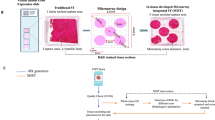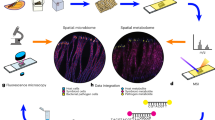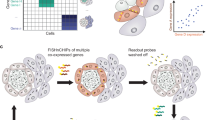Abstract
One purpose of the biomedical literature is to report results in sufficient detail that the methods of data collection and analysis can be independently replicated and verified. Here we present reporting guidelines for gene expression localization experiments: the minimum information specification for in situ hybridization and immunohistochemistry experiments (MISFISHIE). MISFISHIE is modeled after the Minimum Information About a Microarray Experiment (MIAME) specification for microarray experiments. Both guidelines define what information should be reported without dictating a format for encoding that information. MISFISHIE describes six types of information to be provided for each experiment: experimental design, biomaterials and treatments, reporters, staining, imaging data and image characterizations. This specification has benefited the consortium within which it was developed and is expected to benefit the wider research community. We welcome feedback from the scientific community to help improve our proposal.
This is a preview of subscription content, access via your institution
Access options
Subscribe to this journal
Receive 12 print issues and online access
$259.00 per year
only $21.58 per issue
Buy this article
- Purchase on SpringerLink
- Instant access to full article PDF
Prices may be subject to local taxes which are calculated during checkout
Similar content being viewed by others
References
True, L.D. Quantitative immunohistochemistry: a new tool for surgical pathology? Am. J. Clin. Pathol. 90, 324–325 (1988).
Brazma, A. et al. Minimum information about a microarray experiment (MIAME)—toward standards for microarray data. Nat. Genet. 29, 365–371 (2001).
Spellman, P.T. et al. Design and implementation of Microarray Gene Expression Markup Language (MAGE-ML). Genome Biol. 3, RESEARCH0046 (2002).
Stoeckert, C.J. & Parkinson, H. The MGED ontology: a framework for describing functional genomics experiments. Comp. Funct. Genomics 4, 127–132 (2003).
Taylor, C.F. et al. A systematic approach to modeling, capturing, and disseminating proteomics experimental data. Nat. Biotechnol. 21, 247–254 (2003).
Garwood, K. et al. PEDRo: a database for storing, searching and disseminating experimental proteomics data. BMC Genomics 5, 68 (2004).
Jones, A., Hunt, E., Wastling, J.M., Pizarro, A. & Stoeckert, C.J. Jr. An object model and database for functional genomics. Bioinformatics 20, 1583–1590 (2004).
Xirasagar, S. et al. CEBS object model for systems biology data, SysBio-OM. Bioinformatics 20, 2004–2015 (2004).
Jenkins, H. et al. A proposed framework for the description of plant metabolomics experiments and their results. Nat. Biotechnol. 22, 1601–1606 (2004).
Lindon, J.C. et al. Summary recommendations for standardization and reporting of metabolic analyses. Nat. Biotechnol. 23, 833–838 (2005).
Berman, J.J., Edgerton, M.E. & Friedman, B.A. The tissue microarray data exchange specification: a community-based, open source tool for sharing tissue microarray data. BMC Med. Inform. Decis. Mak. 3, 5 (2003).
Stoeckert, C.J., Quackenbush, J., Brazma, A. & Ball, C.A. Minimum information about a functional genomics experiment: the state of microarray standards and their extension to other technologies. Drug Discov. Today Targets 3, 159–164 (2004).
Jones, A.R. et al. The Functional Genomics Experiment model (FuGE): an extensible framework for standards in functional genomics. Nat. Biotechnol. 25, 1127–1133 (2007).
Rayner, T.F. et al. A simple spreadsheet-based, MIAME-supportive format for microarray data: MAGE-TAB. BMC Bioinformatics 7, 489 (2006).
Brazma, A., Krestyaninova, M. & Sarkans, U. Standards for systems biology. Nat. Rev. Genet. 7, 593–605 (2006).
Taylor, C.F. et al. HUPO — Proteomics Standards Initiative (PSI). OMICS 10, 145–151 (2006).
Ball, C.A. & Brazma, A. MGED standards. OMICS 10, 138–144 (2006).
Sansone, S.-A. et al. A strategy capitalizing on synergies: the Reporting Structure for Biological Investigation (RSBI) working group. OMICS 10, 164–171 (2006).
Taylor, C.F. et al. Promoting coherent minimum reporting requirements for biological and biomedical investigations: the MIBBI Project. Nat. Biotechnol. (in the press).
Salgado, D., Gimenez, G., Coulier, F. & Marcelle, C. COMPARE, a multi-organism system for cross-species data comparison and transfer of information. Bioinformatics, published online 1 December 2007 (doi:10.1093/bioinformatics/btm599).
Haudry, Y. et al. 4DXpress: a database for cross-species expression pattern comparisons. Nucleic Acids Res. 36 (database issue), D847–D853 (2007).
Swanson, P.E. Methodologic standardization in immunohistochemistry: a doorway opens. Appl. Immunohistochem. 1, 229–231 (1993).
Taylor, C.R. An exaltation of experts: concerted efforts in the standardization of immunohistochemistry. Hum. Pathol. 25, 2–11 (1994).
McShane, L.M. et al. Reporting recommendations for tumor marker prognostic studies (REMARK). J. Natl. Cancer Inst. 97, 1180–1184 (2005).
Smith, C.M. et al. The mouse Gene Expression Database (GXD): 2007 update. Nucleic Acids Res. 35 (database issue), D618–D623 (2007).
Baldock, R.A. et al. EMAP and EMAGE: a framework for understanding spatially organized data. Neuroinformatics 1, 309–325 (2003).
Whetzel, P.L. et al. Development of FuGO – an ontology for functional genomics experiments. OMICS 10, 199–204 (2006).
Dobashi, Y. et al. Active cyclin A-CDK2 complex, a possible critical factor for cell proliferation in human primary lung carcinomas. Am. J. Pathol. 153, 963–972 (1998).
De Marzo, A.M., Fedor, H.H., Gage, W.R. & Rubin, M.A. Inadequate formalin fixation decreases reliability of p27 immunohistochemical staining: probing optimal fixation time using high-density tissue microarrays. Hum. Pathol. 33, 756–760 (2002).
Sprague, J. et al. The Zebrafish Information Network (ZFIN): the zebrafish model organism database. Nucleic Acids Res. 31, 241–243 (2003).
Carazo, J.M. & Stelzer, E.H. The BioImage Database Project: organizing multidimensional biological images in an object-relational database. J. Struct. Biol. 125, 97–102 (1999).
Rosse, C. & Mejino, J.L. Jr. A reference ontology for biomedical informatics: the Foundational Model of Anatomy. J. Biomed. Inform. 36, 478–500 (2003).
Bard, J., Rhee, S.Y. & Ashburner, M. An ontology for cell types. Genome Biol. 6, R21 (2005).
Bard, J.L. et al. An internet-accessible database of mouse developmental anatomy based on a systematic nomenclature. Mech. Dev. 74, 111–120 (1998).
Hayamizu, T.F., Mangan, M., Corradi, J.P., Kadin, J.A. & Ringwald, M. The Adult Mouse Anatomical Dictionary: a tool for annotating and integrating data. Genome Biol. 6, R29 (2005).
Berman, J.J. A tool for sharing annotated research data: the “Category 0” UMLS (Unified Medical Language System) vocabularies. BMC Med. Inform. Decis. Mak. 3, 6 (2003).
Abd El-Rehim, D.M. et al. Expression of luminal and basal cytokeratins in human breast carcinoma. J. Pathol. 203, 661–671 (2004).
Bova, G.S. et al. Web-based tissue microarray image data analysis: initial validation testing through prostate cancer Gleason grading. Hum. Pathol. 32, 417–427 (2001).
Liu, A.Y. & True, L.D. Characterization of prostate cell types by CD cell surface molecules. Am. J. Pathol. 160, 37–43 (2002).
Kernek, K.M. et al. Fluorescence in situ hybridization analysis of chromosome 12p in paraffin-embedded tissue is useful for establishing germ cell origin of metastatic tumors. Mod. Pathol. 17, 1309–1313 (2004).
McKenney, J.K. et al. Basal cell proliferations of the prostate other than usual basal cell hyperplasia: a clinicopathologic study of 23 cases, including four carcinomas, with a proposed classification. Am. J. Surg. Pathol. 28, 1289–1298 (2004).
Amara, N. et al. Prostate stem cell antigen is overexpressed in human transitional cell carcinoma. Cancer Res. 61, 4660–4665 (2001).
Ayala, G. et al. High levels of phosphorylated form of Akt-1 in prostate cancer and non-neoplastic prostate tissues are strong predictors of biochemical recurrence. Clin. Cancer Res. 10, 6572–6578 (2004).
Bart, J. et al. The distribution of drug-efflux pumps, P-gp, BCRP, MRP1 and MRP2, in the normal blood-testis barrier and in primary testicular tumours. Eur. J. Cancer 40, 2064–2070 (2004).
Browne, T.J. et al. Prospective evaluation of AMACR (P504S) and basal cell markers in the assessment of routine prostate needle biopsy specimens. Hum. Pathol. 35, 1462–1468 (2004).
Chen, D. et al. Syndecan-1 expression in locally invasive and metastatic prostate cancer. Urology 63, 402–407 (2004).
Clayton, H., Titley, I. & Vivanco, M. Growth and differentiation of progenitor/stem cells derived from the human mammary gland. Exp. Cell Res. 297, 444–460 (2004).
Cooray, H.C., Blackmore, C.G., Maskell, L. & Barrand, M.A. Localisation of breast cancer resistance protein in microvessel endothelium of human brain. Neuroreport 13, 2059–2063 (2002).
Giangreco, A., Shen, H., Reynolds, S.D. & Stripp, B.R. Molecular phenotype of airway side population cells. Am. J. Physiol. Lung Cell. Mol. Physiol. 286, L624–L630 (2004).
Gmyrek, G.A. et al. Normal and malignant prostate epithelial cells differ in their response to hepatocyte growth factor/scatter factor. Am. J. Pathol. 159, 579–590 (2001).
Hwang, J.H. et al. Isolation of muscle derived stem cells from rat and its smooth muscle differentiation. Mol. Cells 17, 57–61 (2004); erratum 17, 381 (2004).
Jonker, J.W. et al. The breast cancer resistance protein BCRP (ABCG2) concentrates drugs and carcinogenic xenotoxins into milk. Nat. Med. 11, 127–129 (2005).
Knudsen, B.S. et al. High expression of the Met receptor in prostate cancer metastasis to bone. Urology 60, 1113–1117 (2002).
Larkin, A. et al. Investigation of MRP-1 protein and MDR-1 P-glycoprotein expression in invasive breast cancer: a prognostic study. Int. J. Cancer 112, 286–294 (2004).
Lee, K., Klein-Szanto, A.J. & Kruh, G.D. Analysis of the MRP4 drug resistance profile in transfected NIH3T3 cells. J. Natl. Cancer Inst. 92, 1934–1940 (2000).
Li, R. et al. High level of androgen receptor is associated with aggressive clinicopathologic features and decreased biochemical recurrence-free survival in prostate: cancer patients treated with radical prostatectomy. Am. J. Surg. Pathol. 28, 928–934 (2004).
Martin, C.M. et al. Persistent expression of the ATP-binding cassette transporter, Abcg2, identifies cardiac SP cells in the developing and adult heart. Dev. Biol. 265, 262–275 (2004).
Martin, M.J., Muotri, A., Gage, F. & Varki, A. Human embryonic stem cells express an immunogenic nonhuman sialic acid. Nat. Med. 11, 228–232 (2005).
Master, V.A., Wei, G., Liu, W. & Baskin, L.S. Urothlelium facilitates the recruitment and trans-differentiation of fibroblasts into smooth muscle in acellular matrix. J. Urol. 170, 1628–1632 (2003).
Piotrowska, A.P. et al. Alterations in smooth muscle contractile and cytoskeleton proteins and interstitial cells of Cajal in megacystis microcolon intestinal hypoperistalsis syndrome. J. Pediatr. Surg. 38, 749–755 (2003).
Ricciardelli, C. et al. Androgen receptor levels in prostate cancer epithelial and peritumoral stromal cells identify non-organ confined disease. Prostate 63, 19–28 (2005).
Roudier, M.P. et al. Phenotypic heterogeneity of end-stage prostate carcinoma metastatic to bone. Hum. Pathol. 34, 646–653 (2003).
Rubin, M.A. et al. Quantitative determination of expression of the prostate cancer protein alpha-methylacyl-CoA racemase using automated quantitative analysis (AQUA): a novel paradigm for automated and continuous biomarker measurements. Am. J. Pathol. 164, 831–840 (2004).
Santagata, S. et al. JAGGED1 expression is associated with prostate cancer metastasis and recurrence. Cancer Res. 64, 6854–6857 (2004).
Scotlandi, K. et al. C-kit receptor expression in Ewing's sarcoma: lack of prognostic value but therapeutic targeting opportunities in appropriate conditions. J. Clin. Oncol. 21, 1952–1960 (2003).
Shah, R.B. et al. Androgen-independent prostate cancer is a heterogeneous group of diseases: lessons from a rapid autopsy program. Cancer Res. 64, 9209–9216 (2004).
St Croix, B. et al. Genes expressed in human tumor endothelium. Science 289, 1197–1202 (2000).
Wang, Z. et al. Expression of the human cachexia-associated protein (HCAP) in prostate cancer and in a prostate cancer animal model of cachexia. Int. J. Cancer 105, 123–129 (2003).
Zhigang, Z. & Wenlv, S. Prostate stem cell antigen (PSCA) expression in human prostate cancer tissues: implications for prostate carcinogenesis and progression of prostate cancer. Jpn. J. Clin. Oncol. 34, 414–419 (2004).
Deutsch, E.W. et al. Minimum Information Specification For In Situ Hybridization and Immunohistochemistry Experiments (MISFISHIE). OMICS 10, 205–208 (2006).
Acknowledgements
We thank R. Drysdale, L. Eichner, M. Heiskanen and M. Westerfield for comments and discussions during the preparation of the MISFISHIE specification and C. Emswiler for assistance with the figures. This work was funded in part with support from the US National Institute of Diabetes & Digestive & Kidney Diseases to members of the Stem Cell Genome Anatomy Projects Consortium, including DK63483 to J. Gordon, DK63481 to I. Lemischka, DK63400 to M. Little, DK63630 to A. Liu and DK63328 to L. Zon (Children's Hospital Boston).
Author information
Authors and Affiliations
Corresponding author
Supplementary information
Rights and permissions
About this article
Cite this article
Deutsch, E., Ball, C., Berman, J. et al. Minimum information specification for in situ hybridization and immunohistochemistry experiments (MISFISHIE). Nat Biotechnol 26, 305–312 (2008). https://doi.org/10.1038/nbt1391
Published:
Issue date:
DOI: https://doi.org/10.1038/nbt1391
This article is cited by
-
Modeling community standards for metadata as templates makes data FAIR
Scientific Data (2022)
-
Towards community-driven metadata standards for light microscopy: tiered specifications extending the OME model
Nature Methods (2021)
-
Abnormal histology in testis from prepubertal boys with monorchidism
Basic and Clinical Andrology (2020)
-
Use of multicolor fluorescence in situ hybridization to detect deletions in clinical tissue sections
Laboratory Investigation (2018)



